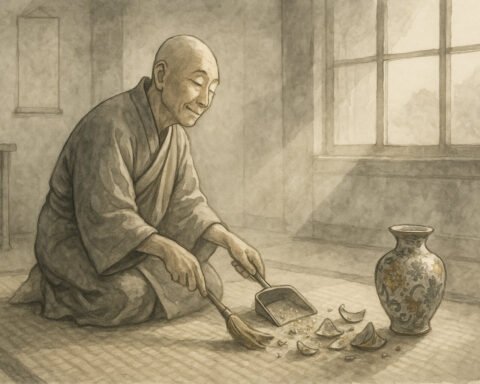Table of Contents
Introduction
Mental health awareness spikes every May — and again during Mental Wellness Month — but despite the hashtags, many people feel more anxious, scattered, and burned out. Awareness without action is like knowing the gym exists yet never picking up a weight. The Stoics argued that knowledge is only real when it becomes habit. As Marcus Aurelius put it, “What stands in the way becomes the way” — obstacles are raw material for virtue, not excuses to stop. (Meditations 5.20).
This guide reframes mental health awareness as daily practice built on Stoic principles and modern clinical psychology. You’ll learn why a 2,000-year-old operating system maps onto today’s brain science (prefrontal control over limbic reactivity, cognitive distancing, exposure, and acceptance), and you’ll leave with a 7-day plan you can start now.
The Stoic’s Daily Triad: Perception, Action, Will
Framework: Perception (how you see) → Action (what you do) → Will (how you endure and love what you can’t change).
- Perception aligns with cognitive reappraisal and distancing—skills shown to down-regulate amygdala reactivity and improve emotion regulation.
- Action aligns with behavioral activation and values-based behavior—doing the next right thing reduces rumination and learned helplessness.
- Will aligns with acceptance and psychological flexibility (the core of ACT). Greater flexibility is linked to better mental health across conditions.
This triad turns mental health awareness into mental fitness.
Perception: See clearly, feel steadily
1) The Dichotomy of Control (Epictetus) meets perceived control research
Epictetus opens his Enchiridion bluntly: “Some things are in our control and others not.” Thoughts, choices, and responses are up to us; reputation, weather, and other people aren’t. (Enchiridion 1). Practically, that’s locus of control: emphasizing what you can influence while dropping what you can’t.
Why it works: Decades of research link a sense of control to better mental health; internal control tends to buffer stress, while external, chance-based control often predicts worse anxiety and depression. (See cohort and pandemic-era studies).
How to practice (60 seconds):
- List 3 controllables (effort, schedule, words) and 3 uncontrollables (others’ opinions, delays, past).
- Commit to act only on the first column — then release the second.
Use this micro-drill during Mental Health Awareness Month meetings, commutes, or before difficult conversations.
2) Cognitive Reappraisal & Distancing (Stoic reframing in lab clothes)
Epictetus again: “It is not things that disturb us, but our judgments about things.” Short, but it aligns with CBT’s core premise: beliefs drive feelings.
Neuroscience shows that reframing (reappraisal) activates prefrontal networks that modulate the amygdala. Self-distancing — speaking to yourself in the third person (“Alex, what matters now?”) — further reduces emotional reactivity without heavy cognitive effort.
- In experiments, people who self-distanced showed lower emotional and cardiovascular reactivity and less intrusive rumination later.
- Third-person self-talk helps in real time, confirmed by ERP/fMRI work.
Try it: When spiraling, narrate in third person: “Alex, notice the urge. Breathe. Choose the next right step.”
3) Negative Visualization (premeditatio malorum)
Seneca taught “rehearsal” of adversity to shrink shock and build gratitude. In Letter 18 he advises setting aside days to eat simple food and wear coarse clothes, asking: “Is this what I feared?”—a form of voluntary hardship that inoculates against stress
Modern psychology echoes this: defensive pessimism and imaginal exposure can reduce anxiety by planning for obstacles and rehearsing coping. A large literature on negativity bias shows why our attention tilts toward threats; Stoic visualization tames that tilt by meeting threat on your terms.
Two-minute drill: Picture a plan failing. Write (1) What I’d do first, (2) Who I’d call, (3) What virtue I’d practice (wisdom/courage/justice/temperance).
4) Journaling (Meditations → evidence)
Marcus Aurelius’ Meditations is basically a Stoic CBT journal. Modern trials show expressive writing can reduce anxiety in students, with mechanisms overlapping exposure and reappraisal; journaling that promotes distancing seems especially potent.
Prompt (evening):
- Perception: What judgment did I change today?
- Action: What duty did I do regardless of mood?
- Will: What did I accept—and even appreciate?
Action: Do the next right thing
Duty over passion: a surprising anxiety reducer
“Follow your passion” can create pressure and endless self-monitoring. The Stoics advise duty: Do what’s yours to do for the common good. Clinically, that’s behavioral activation—schedule meaningful, value-aligned acts and your mood follows. Evidence?
Eleven years of “Stoic Week” data show consistent reductions in negative emotions (e.g., “feeling negative” down 29% in 2023) and increases in purpose after just one guided week of Stoic practice. While self-selected and non-randomized, the scale and consistency are notable.
Workday application (mental health awareness at work):
- Start meetings with the Control List (what’s ours vs. not).
- End meetings with commitments by virtue: What’s the courageous/just action I’ll take?
Micro-habits that compound
- One-minute prosoche (attention): three slow nasal breaths, label thoughts “judgment, not fact.”
- Five-minute value block: schedule one act serving a person or team (justice).
- Ten-minute walk call: pair movement with service (call someone who needs it).
Voluntary Hardship: training stress-response systems
Stoics practiced temperance through modest discomfort. Today’s equivalents—sauna (heat) and cold exposure—are modern “stress vaccines.” Early clinical work shows whole-body hyperthermia can rapidly reduce depressive symptoms versus sham; mechanisms likely include thermoregulation and inflammatory signaling.
Observational and experimental sauna studies also point to mood benefits (with safety caveats: intensity matters—~80°C protocols improved mood; extreme 120°C increased tension/fatigue in one study).
Cold exposure evidence ranges from case reports and acute studies (mood elevation after cold immersion; catecholamine spikes) to emerging reviews suggesting potential mental health benefits—still preliminary, but consistent with the Stoic idea of training distress tolerance.
- For a practical application of voluntary discomfort, see our guide to cold plunge protocols and sauna heat therapy.
- Cold: /guides/cold-plunge-protocols
- Heat: /guides/sauna-heat-therapy
As Seneca wrote, “Set aside a certain number of days… with the scantiest and cheapest fare… ‘Is this the condition that I feared?’” (Letter 18).
Will: Love fate, build antifragility
Amor fati: acceptance without passivity
Amor fati—“love of fate”—is the Stoic commitment to embrace events outside control and use them for virtue. In modern therapy, that looks like acceptance and psychological flexibility (the heart of ACT). Meta-analytic and process research link flexibility to improvements across anxiety, depression, and chronic conditions.
Practice: When a setback hits, say: “Good—training.” Then identify the virtue it trains (patience, courage), and take one aligned action.

Objection: “Isn’t Stoicism emotional suppression?”
No. Research on self-distancing shows reduced reactivity without avoidance; Stoicism aims to feel appropriately by judging wisely, not by numbing.
Evolutionary psychology explains the “why”
Our brains evolved for threat detection—bad can be stronger than good—so untrained minds over-weight negatives. Stoic drills counterprogram that ancient bias with deliberate perception, steady action, and flexible will.
Mental health awareness, structured: your daily plan
Morning (Perception, 5–10 min)
- 3+3 Control list (what’s mine vs. not).
- 2 min negative visualization + “If this, then I will…” plan.
- 1 min third-person cue: “[Your Name], do the next right thing.”
Midday (Action, 5–10 min)
- One duty act (email of help, fix the small broken thing, honest update).
- Voluntary hardship: brief cold rinse (30–120 s) or short sauna (10–20 min) if available; be medically safe.
Evening (Will, 5–10 min)
- Journal: Perception / Action / Will prompts.
- Amor fati reflection: write one sentence transforming a setback into training.
If you’re in therapy for depression, share this plan with your mental health professional—it integrates cleanly with CBT and ACT.
Mental health awareness questions answered
What is a Stoic approach to mental health awareness?
A practice-based system: train Perception (reframe & distance), take Action (duty over mood), and fortify Will (accept & love fate). Five-minute drills daily outperform sporadic inspiration.
Is Stoicism toxic or emotion-suppressing?
No—Stoicism aims for appropriate emotion by changing judgments. Research shows self-distancing reduces distress without avoidance.
How is Stoicism different from therapy?
Stoicism is a philosophy of living; therapy is a clinical treatment. They overlap (CBT/ACT mirror Stoic tools), and many clinicians integrate both. Consult a licensed professional for diagnosis and care.
Can Stoic practices help with anxiety or low mood?
Evidence supports reappraisal, distancing, expressive writing, and even heat therapy as helpful components. These should complement, not replace, professional treatment when needed.
7-Day Stoic Challenge for Modern Mental Wellness
Each day uses the Triad (Perception, Action, Will). Keep sessions short (10–20 minutes total) to boost adherence. If symptoms are severe or you’re unsure, coordinate with a mental health professional.
Day 1 — Perception (Clarity)
- Morning: Control List (3+3) + 1 negative visualization.
- Action: Send one candid update you’ve delayed.
- Will: Journal one sentence of amor fati about a small setback.
Day 2 — Action (Duty)
- Morning: Plan one duty that helps someone else first.
- Action: Do it regardless of mood.
- Will: Reframe any friction as training in justice.
Day 3 — Will (Acceptance)
- Morning: Third-person self-talk for 60 seconds; set a realistic implementation intention (“If X happens, then I’ll Y”).
- Action: Brief voluntary hardship (cold 30–120s or sauna 10–20m; safety first)
- Will: Write what the hardship taught you.
Day 4 — Perception (Reappraisal)
- Morning: Reappraise one annoyance: What story helps me act better?
- Action: Choose a small courageous task you’ve avoided for 7+ days; do it.
- Will: Journal: What did courage feel like in the body?
Day 5 — Action (Consistency)
- Morning: Control List + schedule two value blocks (15 min).
- Action: One block for craft (wisdom), one for service (justice).
- Will: Gratitude for one obstacle—how did it sharpen you?
Day 6 — Will (Amor Fati)
- Morning: Negative visualization of a plan failing; map a response.
- Action: Repeat voluntary hardship (heat or cold).
- Will: Turn a disappointment into a sentence you love: “Good—more reps at patience.”
Day 7 — Integration
- Morning: Review the week; note the highest-leverage habit.
- Action: Share one insight publicly (team/family).
- Will: Commit to a 4-week extension with one metric (sleep, steps, journal strea

Final Thoughts: Make Mental Health Awareness Visible
Awareness without practice is just trivia. The Stoic answer—Perception, Action, Will—turns mental health awareness into daily training. See clearly (name what’s in your control), do the next right thing (duty over mood), and welcome reality as your sparring partner (amor fati). That’s not abstract philosophy; it’s a repeatable operating system that aligns with modern psychology and works in the messy middle of real life.
So let’s make this concrete:
- Begin today. Write your 3 controllables and 3 uncontrollables.
- Do one duty that serves a person or project, regardless of how you feel.
- Choose one voluntary hardship (brief cold, short sauna, or skip a comfort) to train steadiness.
- Close the day with a three-line journal: Perception, Action, Will.
If you’re working with a mental health professional or in therapy for depression, bring this framework to your next session; it integrates cleanly with CBT/ACT and gives you practice reps between appointments.
As Marcus Aurelius reminded himself, “The obstacle is the way.” The difference between knowing and growing is a single rep done today.
Your next step:
- Start Day 1 of the 7-Day Stoic Challenge for Modern Mental Wellness (control list → duty → journal).
- Commit to one keystone habit from the Triad for the next 30 days.
Make mental health awareness something you can point to on your calendar. Begin now.
👉 Looking to deepen your resilience training? Read my article: Infrared Sauna Health Benefits: The Definitive 2025 Guide







